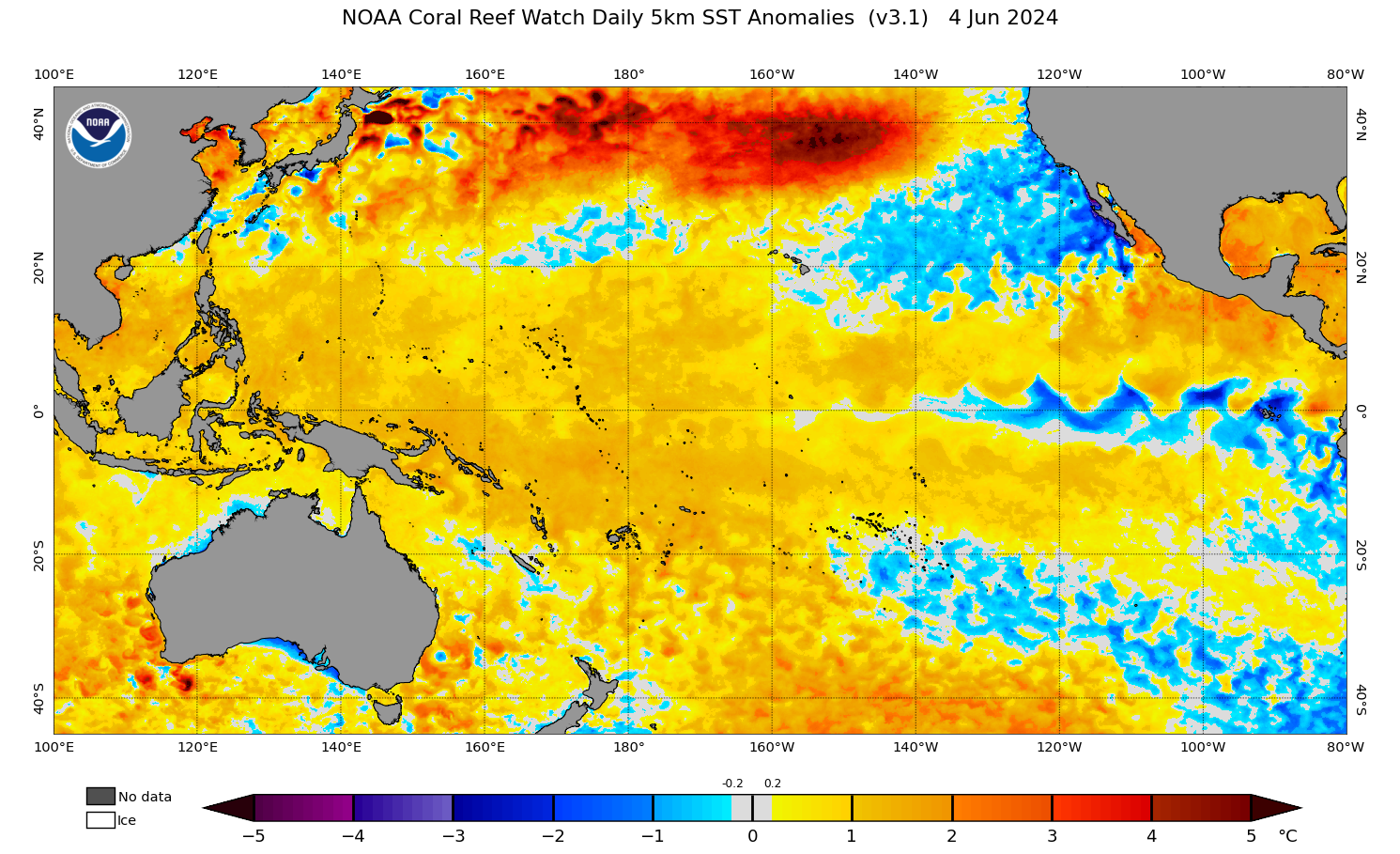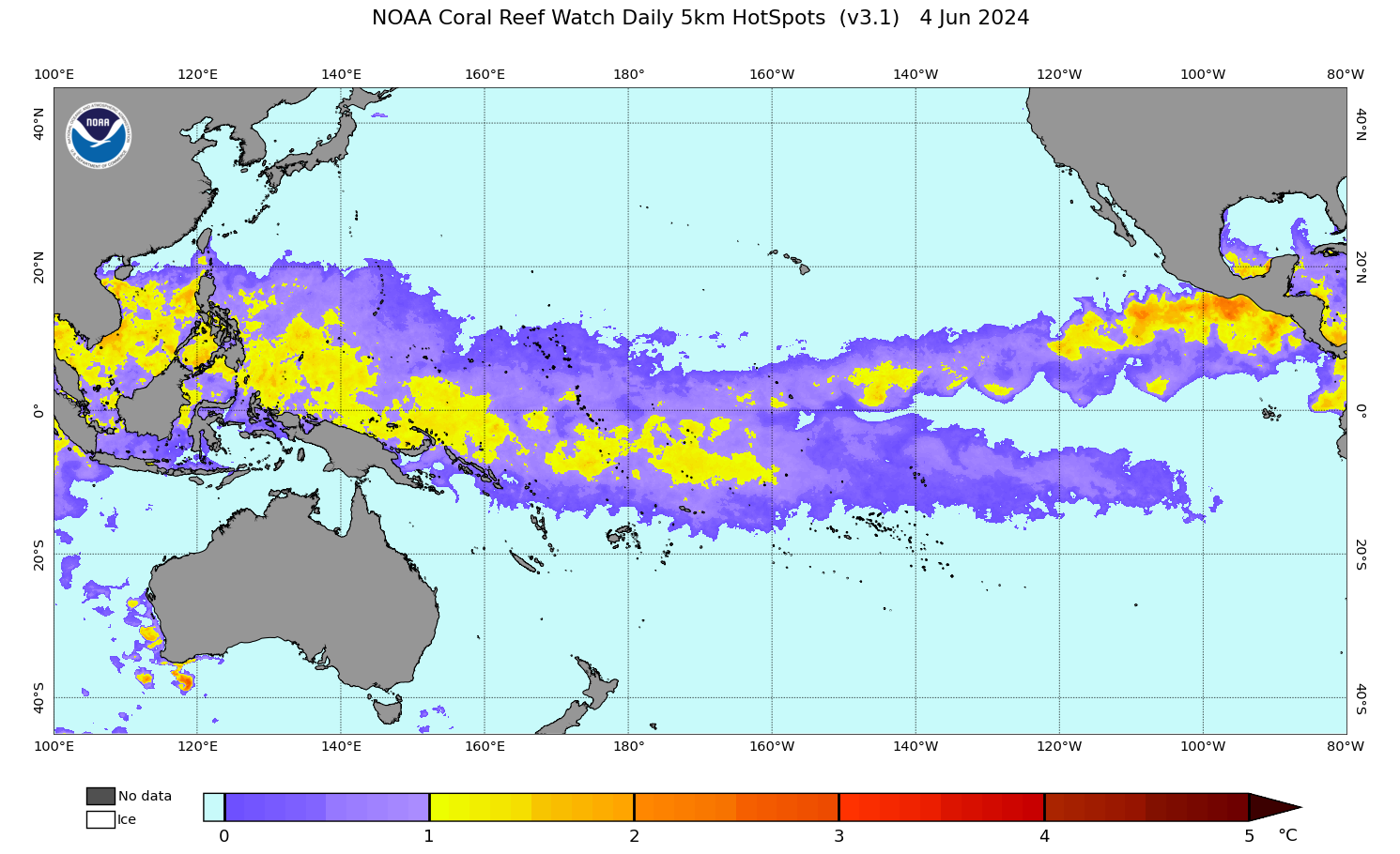Coral Bleaching Heat Stress Analysis and
Seasonal Guidance through September 2024
(Released June 5, 2024)
****On April 15, 2024, in partnership with the International Coral Reef Initiative, NOAA announced the
4th Global Coral Bleaching Event.
Since the beginning of 2023, and as of this writing, 66 countries and territories worldwide have documented coral bleaching, during the
ongoing global event, with some locations reporting bleaching in both 2023 and 2024.****
Current conditions:
NOAA Coral Reef Watch's near real-time satellite monitoring (images dated June 4, 2024) indicates that below-average sea surface temperatures (SSTs) have been gradually expanding in the eastern equatorial Pacific Ocean since late April (Figure 1). Since late May 2024, below-average SSTs have intensified in both the northern Pacific (from the Main Hawaiian Islands to the west coast of North America) and in the southern Pacific (from French Polynesia to the west coast of South America). Additionally, a swath of below-average SSTs remains in the northwestern Pacific, stretching south and west from the Northwestern Hawaiian Islands (NWHI) toward the Commonwealth of the Northern Mariana Islands (CNMI). Conversely, above-average SSTs dominate along the Central American coast and throughout the western Pacific.
As of May 9, 2024, the NOAA National Centers for Environmental Prediction's (NCEP) ENSO Alert System status remains at El Niño Advisory/La Niña Watch. A transition from El Niño to ENSO-neutral is likely in the next month. La Niña may develop in June-August (49% chance) or July-September 2024 (69% chance).

|
||
|
Figure 1. NOAA Coral Reef Watch's Satellite Sea Surface Temperature (SST) Anomaly product for the Pacific region. |
||
Over the past three months, Coral Bleaching HotSpots >1 °C have lessened in the most southern portions of the south Pacific (south of 20 °S latitude), but they remain active in the western Pacific (from American Samoa west toward the Coral Triangle), and in the eastern Pacific around Panama, El Salvador, and, most recently, southern Mexico, extending west toward Clipperton Island, France (Figure 2). NOAA CRW's daily 5km satellite Regional Virtual Stations currently indicate American Samoa and the Northern Cook Islands are at Bleaching Alert Level 4, which presents a risk of severe, multi-species mortality (>50% of corals) (Figure 3). We recommend users consult the single-pixel satellite Virtual Stations for the Samoan Islands, to better understand accumulated heat stress at specific reef sites. Bleaching Alert Level 3, associated with a risk of multi-species mortality, exists in Tuvalu, Wallis and Futuna, and the Phoenix Islands (Kiribati). SSTs are trending downward due to seasonal cooling in both the Samoas and Wallis and Futuna; heat stress accumulation has likely peaked in these two locations. Heat stress in Northern Tonga has also decreased to Bleaching Alert Level 2, after previously maxing out at a Degree Heating Week (DHW) of 15.2 °C-weeks, which is near the threshold for Alert Level 4 conditions (16 ≤ DHW < 20 °C-weeks). Costa Rica is at Bleaching Alert Level 3, and a large number of other reef areas throughout the Pacific continue at Bleaching Alert Levels 1-2. Please visit NOAA CRW's daily 5km satellite Regional Virtual Stations page to learn more.

|
||
|
Figure 2. NOAA Coral Reef Watch's Satellite Coral Bleaching HotSpot product for the Pacific region. |
||

|
||
|
Figure 3. NOAA Coral Reef Watch's Satellite Bleaching Alert Area (7-day maximum) product for the Pacific region. |
||
**NOTE**: On December 15, 2023, NOAA CRW implemented a revised coral bleaching heat stress category system for its Bleaching Alert Area product. Extreme accumulations of coral bleaching heat stress in 2023, in multiple regions of the world (especially in the eastern tropical Pacific Ocean and Greater Caribbean), which were confirmed by in-water observations, necessitated the introduction of additional Bleaching Alert Levels. This development is a refinement of the original system that only used Bleaching Alert Levels 1 and 2. The new Alert Levels 3-5 provide important, added detail, for when the magnitude of extreme heat stress exceeds the threshold of Alert Level 2 conditions.
For managers: we understand that coral bleaching response plans, incident action plans, and restoration plans around the world rely on NOAA Coral Reef Watch's Bleaching Alert Levels, to assist with planning and implementation of work by your in-water monitoring and management networks. Any actions you would have taken previously at Bleaching Alert Level 2 still apply. We recognize, however, that discussions may need to occur now, regarding appropriate actions for your networks when the extreme Bleaching Alert Levels 3-5 are predicted.
Since March 2024, coral bleaching has been documented in American Samoa, the Philippines, Wallis and Futuna, New Caledonia, Indonesia, French Polynesia, Vietnam, Costa Rica, and along the Great Barrier Reef (Australia).
NOAA CRW would be very grateful if local stakeholders would continue sharing their in-water data and observations of coral bleaching/no bleaching, to inform what has been and is being observed on their reefs. Users can contribute their data to NOAA CRW via email (to coralreefwatch@noaa.gov), a Google Form, and/or via a more detailed, quantitative observations questionnaire. (Please see https://coralreefwatch.noaa.gov/satellite/research/coral_bleaching_report.php for more information.)
Predicted conditions:
NOAA CRW's most recent, modeled Four-Month Coral Bleaching Outlook (Figure 4) projects heat stress will dissipate around American Samoa by the end of June 2024, but accumulate north of Papua New Guinea (which is already at Bleaching Alert Level 3) and toward the Federated States of Micronesia through August. Guam and CNMI are predicted to reach Bleaching Alert Level 1 by September 2024. Heat stress is predicted to subside periodically in July in the eastern Pacific but accumulate again in August.

|
||
|
Figure 4. NOAA Coral Reef Watch's Four-Month Coral Bleaching Outlook of June 4, 2024, for the period June-September 2024, for the Pacific region. |
||
***CRW recommends regular review of its Four-Month Coral Bleaching Outlook maps (https://coralreefwatch.noaa.gov/satellite/bleachingoutlook_cfs/index.php) and near real-time satellite product updates (https://coralreefwatch.noaa.gov/product/5km/index.php), for all regions of interest/concern, over the months ahead.***
CRW's current satellite and modeled products can be found at:
https://coralreefwatch.noaa.gov/index.php
CRW's modeled Four-Month Coral Bleaching Heat Stress Outlooks can be found at:
https://coralreefwatch.noaa.gov/satellite/bleachingoutlook_cfs/outlook_cfs.php
CRW's 5km satellite Regional Virtual Stations can be found at:
https://coralreefwatch.noaa.gov/product/vs/map.php
Sign up for automated bleaching alert emails for CRW's 5km Regional Virtual Stations at:
https://coralreefwatch.noaa.gov/subscriptions/vs.php
Please report bleaching events (or non-events) at:
https://coralreefwatch.noaa.gov/satellite/research/coral_bleaching_report.php
Disclaimer
The content posted on this web page solely represents the opinions of the authors and does not constitute a statement of policy, decision, or position on behalf of NOAA or the US Government.
The appearance of external links on this World Wide Web site does not constitute endorsement by the Department of Commerce/National Oceanic and Atmospheric Administration of external Web sites or the information, products or services contained therein. For other than authorized activities, the Department of Commerce/NOAA does not exercise any editorial control over the information you may find at these locations. These links are provided consistent with the stated purpose of this Department of Commerce/NOAA Web site.